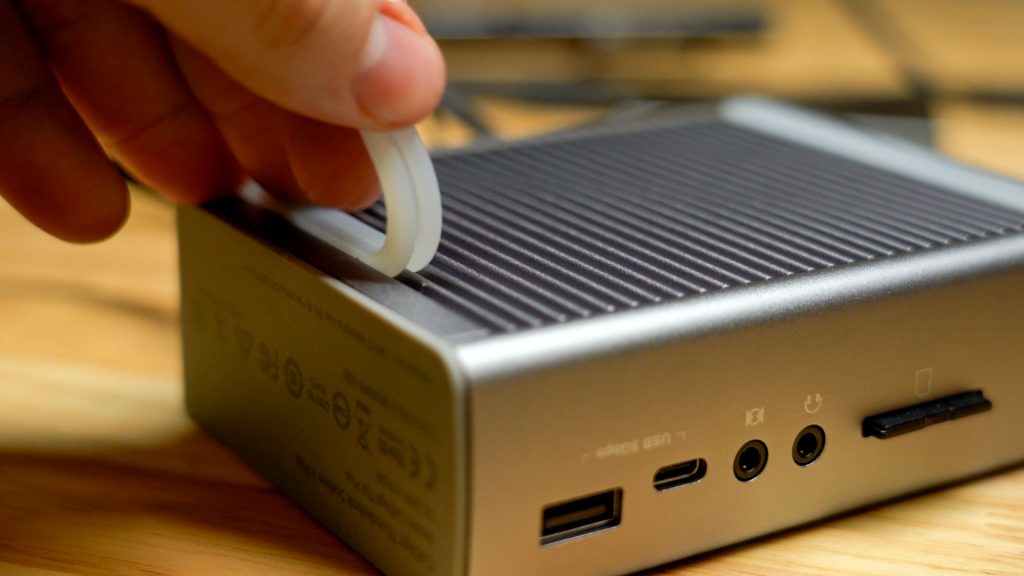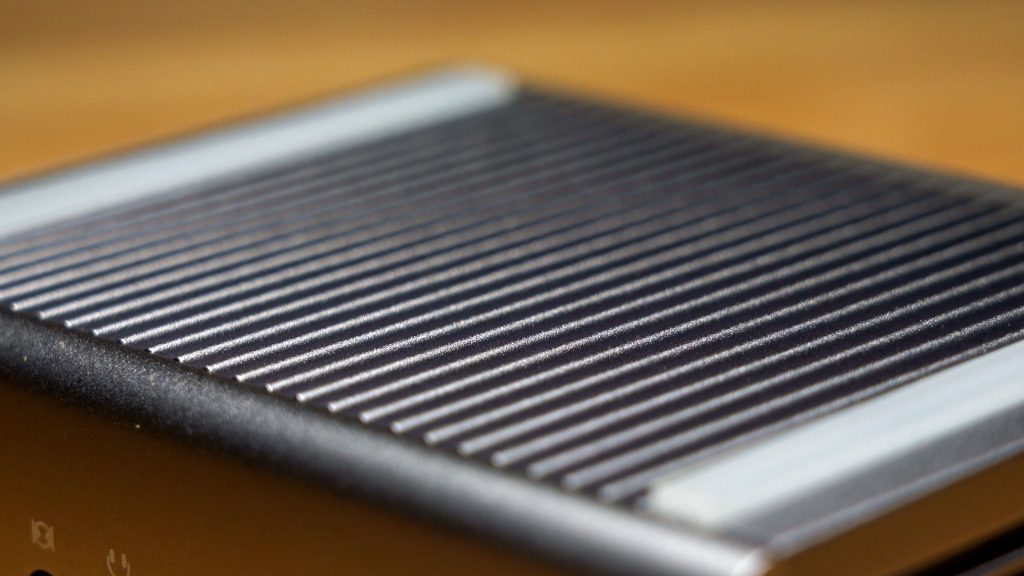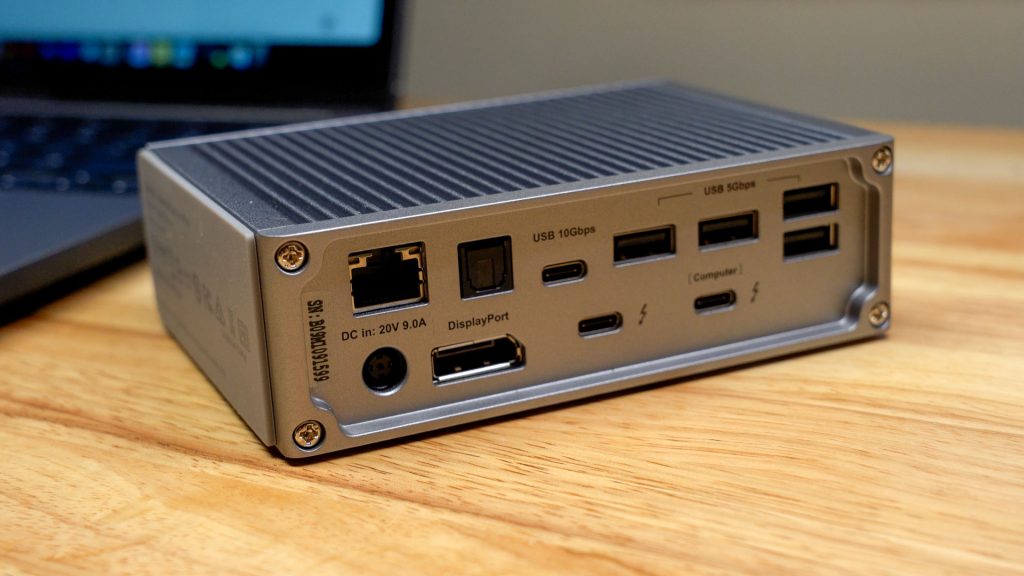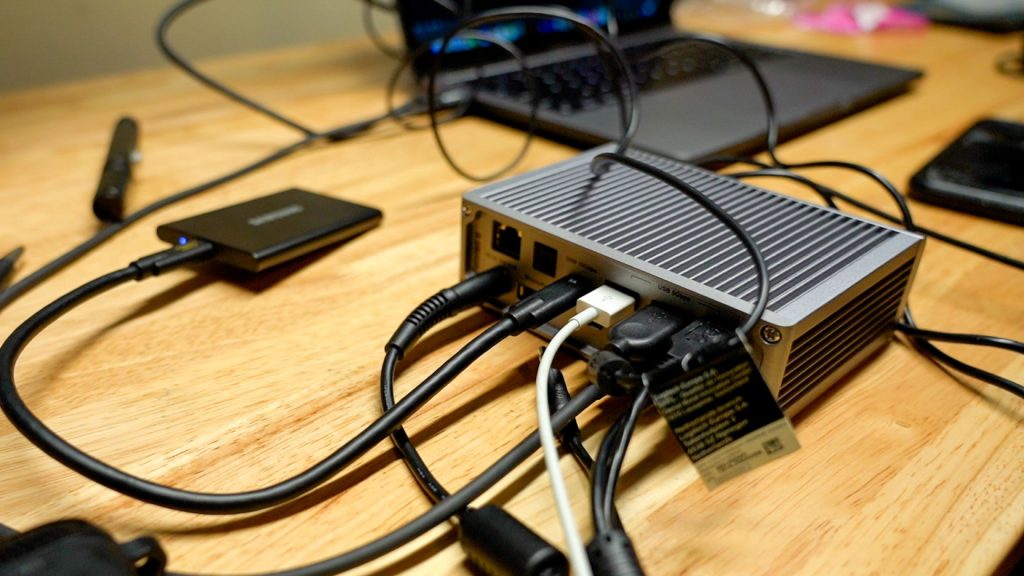
This little gray box, which Caldigit has named the TS3 Plus, might just be the cure to the plague of the perishing ports.
As a Thunderbolt 3 capable device, the TS3 Plus (shortened to TS3 here) is highly capable of delivering data for nearly all of your I/O needs. From display to audio to Ethernet connection, you can do nearly anything with a single cable.
This expansion is particularly important as laptop manufacturers become more stingy with their port selection. For about a year, I’ve been using the 2020 MacBook Pro which only has 2 Thunderbolt 3 ports. I’ve been grateful for TS3 and its extra ports on many occasions.
Let’s take a closer look at the TS3, and decide whether you should consider purchasing it for yourself.
Disclaimer: We use affiliate links to help monetize this site and support content like this. These affiliate programs do not affect our content and our opinions about these products are our own. If you’re interested in supporting this work, a link can be found at the end of the article.
Build Quality
The build quality of the TS3 is very premium, and the device has a quite solid feel. It’s made entirely of metal, probably aluminum, and is very sturdy. Weighing in at _____, it has a decent amount of heft which keeps it from sliding across a desk. It can also be oriented vertically with the built-in rubber pad, or two rubber strips can be applied to allow horizontal orientation. There has never been an instance where the TS3 has accidentally slid off the table while I was using it.



A striking feature of the TS3’s exterior is the ribbed metal texture covering its sides. They serve multiple purposes: firstly as a place for the rubber strips to attach, to make the device look cool and as a means of passive cooling.
That’s not a confirmed feature, but there is good reason to provide heat dispersion. Especially during long sessions, the TS3 starts to heat up noticeably. I first bought the device to allow me to produce live streams for a local swim team, which last a few hours. I connected several devices and by the end of the meet, the TS3 was very warm to the touch. I can’t say I’m surprised given the amount of data flowing through it, but the heat can be mildly concerning if it’s not expected.
As a unit, the TS3 is very well built. One qualm I have is with the ports themselves. Occasionally, cables being inserted into the ports will be met with a good deal of resistance. There’s a saying often applied to electronics: “don’t force it”. I sometimes feel as though I’m forcing the plugs in place, and it’s not a good feeling.
Utility & Port Selection
In terms of port selection, the CalDigit TS3 Plus offers a total of 14 ports: five USB type A ports, three USB-C ports, an optical audio port, a gigabit Ethernet port, a full size DisplayPort 1.2 port, 3.5mm audio output, 3.5mm line in and an SD card reader. It could be considered a 15-in-1 if it’s charging capability were to be included in the count. The last port is a required connection for the computer – the TS3 won’t work without a computer plugged in that port.

Here’s a table detailing the speed and quantity of each port.
Front Ports
| Port Type | Quantity | Speed | Function |
| UHS-II SD Card Slot | 1 | Up to 312MB/s | Reading and writing to SD cards up to UHS-II specification |
| 3.5mm Headphone Jack | 1 | N/A | Allows output of sound to 3.5mm cable |
| 3.5 MM Line In Port | 1 | N/A | Allows input of sound via 3.5mm cable |
| USB-C (Data Only) | 1 | USB 3.1 Gen 1/5Gbps | Data transfer only of up to 5 Gbps |
| USB-A Gen 1 | 1 | 5 Gbps | Standard USB-A port with 5 Gbps and 5V 1.5A power delivery |
Rear Ports
| Port Type | Quantity | Speed | Function |
| RJ-45 Ethernet | 1 | 1 Gbps | Internet connectivity via ethernet |
| Digital Optical Audio | 1 | N/A | Allows output of audio via digital optical cable |
| USB-C 3.1 Gen 2 | 1 | 10 Gbps | Data transfer only of up to 10 Gbps |
| USB-A Gen 1 | 4 | 5 Gbps | Standard USB-A port with 5 Gbps data delivery and 5 V power delivery |
| DC 20V Port | 1 | N/A | Required power port |
| Full Size Display Port 1.2 | 1 | Up to 17.28 Gbps | Allows display output via DisplayPort |
| USB-C Thunderbolt 3 | 1 | Up to 40 Gbps | Downstream port allowing transfer of full 40 Gbps speed |
| USB-C Thunderbolt 3 | 1 | Up to 40 Gbps | Host port – required connection for dock use. Up to 87W charging and 40 Gbps data rate |
While this is an impressive offering, I do have some questions about the selection. To me, the most obvious outlier is the full size DisplayPort. While DisplayPort is native to the Thunderbolt 3 specification, it is much less common than HDMI. Despite the TS3 being aimed at power users, most other consumers have probably never heard of DisplayPort. This means you’ll encounter it much less in the wild – you’ll have to plan ahead when considering what cables to bring from place to place.
Adapters exist to remedy this issue but it should be noted that an active adapter is required to convert the signal. A generic cable will not work – which I found out the hard way. CalDigit probably assumed that users would build a work station around the TS3 and would thus accommodate the I/O with cable selection. While I personally use DisplayPort with my desktop monitors, I think the port choice is a bit presumptive and would love to see an alternate version with an HDMI port.
My other question about the TS3’s port selection is an optical audio port. This is even rarer than a DisplayPort connection – I am curious how many people frequently use optical audio. Someone commented on my video review of the TS3 saying they use it frequently as a music producer, which I understand. However, the last time I used optical audio was in 2012 when I plugged my Triton headset into my Playstation 3. I would love to hear why they selected optical audio instead of an alternate video output or additional I/O offerings.

Who is it for?
I would bet that this dock is aimed at creatives looking to expand their device (probably a laptop) to a desktop experience. Hunching over a laptop isn’t the ideal working experience, and the TS3 solves that problem quickly. Plug in a mouse, keyboard and monitor and you’ve created a complete home office. One of my favorite features of the TS3 its ability to charge your computer while plugged in. It makes it much easier to use and keeps my desk much tidier. The included Thunderbolt 3 cable will handle power delivery to your computer and the data delivery to your devices. Very impressive.
These days, there aren’t many reasons to buy a prebuilt desktop over a laptop. The only reason I still own my desktop is to play games using its discrete GPU. If I had a laptop with a dedicated GPU, I would probably play games there instead. However, I do prefer the ergonomics of a desktop setup. That’s the point of the TS3 – allow your device a whole lot more flexibility.
I’ve had no problems getting the TS3 to do what I need it to. Even when I was managing the livestream, there was no evidence of throttling or lag from any of the devices. Because of the device’s need to be powered externally, you lose any mobility you might have had while using a dongle or individual adapter. I had a cheap dongle before using this, and it was pretty nice to walk around with an SD card plugged in and not be chained to the wall by a power adapter. But, if you’re going to buckle down for a serious work session it’s unlikely that you’ll need much mobility anyway.
Should I buy it?
For me, the TS3 was well worth the money. I’m a believer in overkill when it comes to tech purchases and this was no exception. Most users will be hard-pressed to push this little gray box to its limits. The 40Gb/s delivered by Thunderbolt 3 is a modern marvel. It’s extremely impressive to connect just one cable and have it support anything I need it to do.
Most recently, I purchased some peripherals that will help the TS3 transform my MacBook into a complete desktop experience. I already have a PC gaming setup, so I could connect to the moni
That being said, it is expensive. At nearly $270, it’s probably priced out of most peoples’ budgets. If you only need to connect one device, you’ll be much better off buying a dongle or an adapter. If you find yourself wishing your computer could multitask a little better, you should at least consider the TS3 Plus. If you can foot the bill, it will last you a long time and can significantly increase your productivity.
If you’re interested in learning more about the Caldigit TS3 Plus or making a purchase, you can do so through this paid link. It doesn’t cost you anything additional and helps support content like this. Thanks for reading!
Official disclaimers: As an Amazon Associate I earn from qualifying purchases. I get commissions for purchases made through links in this post.
